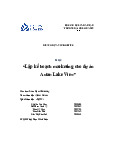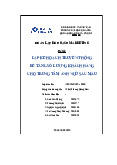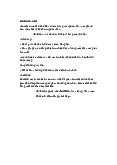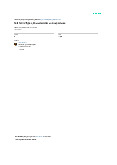


Preview text:
Exam based Problem Questions on Tax Administration-Q&A
1.Nicole has just received an amended assessment that shows a significant increase in her taxable
income and tax payable. She thinks the ATO is being very heavy handed in their approach to her and
is treating her unfairly. What options does Nicole have to challenge this amended assessment – she
wants to claim that it is invalid and excessive. In relation to each avenue of challenge, at a basic level,
what does Nicole need to show?
In order to challenge the validity of the amended assessment, Nicole would need to apply for judicial
review of the making of the assessment under s 39B of the Judiciary Act. The combined effect of s 175
of the ITAA 1936 and s 350-10 Sch 1 of the TAA creates a presumption that an assessment is valid. In
order to succeed in establishing that the assessment is invalid, on the authority of the High Court’s
decision in FCT v Futuris, Nicole will need to show that the assessment was made in bad faith or as a
result of conscious maladministration. This is very difficult to case to make.
In order to challenge the amount of the assessment (that is, to argue it is excessive), Nicole will use
the objection and appeals process provided in Part IVC of the TAA. Nicole must first object against the
assessment in writing, in the approved form, and stating in full and in detail the grounds that she relies
upon (s 14ZU of TAA). If the Commissioner decides to disallow the objection, Nicole can then apply to
the Administrative Appeals Tribunal to review this decision or appeal to the Federal court against the
decision (s 14ZZ of TAA). In either case, Nicole has the burden of proving both that the assessment is
incorrect and what the assessment should have been (ss 14ZZK and 14ZZO of TAA).
2. Mary Jones is an accountant and registered tax agent who specialises in small business clients,
especially those running restaurants and cafes. As part of the investigations of the Black Economy
Taskforce, Mary has been identified as a potential facilitator of tax evasion. In particular, evidence
suggests that Mary makes arrangements to allow non-declared cash income to be funnelled overseas
and then back into legitimate accounts in Australia. The ATO issues a s 353-10 notice to Mary requiring
that she provide any and all information she has regarding the business accounts of clients running
cafes (including balance sheets and profit and loss accounts) and any employees of those businesses.
Is Mary required to comply with this notice? Can she object to supplying this information on the basis
that to do so would violate her duty of confidentiality to her clients?
This question deals with s 353-10 of Sch 1 TAA (formerly s 264 of ITAA 1936), the Commissioner’s
power to obtain information and evidence: [24.510]-[24.620]. The ATO notice requires that Mary
produce any documents in her custody or under her control that are specified in the notice. For these
purposes, “document” includes both physical and electronic records: meaning given to “document”
in s 2B of the Acts Interpretation Act 1901 (Cth).
The notice must be sufficiently clear to convey the information that is being sought: ANZ v Konza
[2012] FCAFC 127. Failure to comply with a s 353-10 notice can be an offence under s 8C or 8D of TAA
and the notice overrides any duty of confidentiality to Mary’s clients: Smorgon v ANZ (1976) 134 CLR 475.
Although the ATO extends an administrative concession similar to legal professional privilege to
accountants, this “accountants’ privilege” does not protect source documents, such as balance sheets
and profit and loss accounts, from access, so Mary will be required to provide the requested
information. In exceptional circumstances, which may be the case here as the suggestion is that
criminal tax evasion has been facilitated by Mary, the ATO reserves the right to access all accountants’ records.
Mary may be subject to criminal prosecution if she had been facilitating tax evasion and, as a
registered tax agent, will have breached the Code of Professional Conduct found at Pt 3 Div 30 of the
Tax Agents Services Act 2009: [24.695]. Subdivision 30-B deals with administrative sanctions for failure
to comply with the Code of Professional Conduct. These include: written cautions; orders to complete
additional education; suspension or termination of registration. Part 5, Div 50 contains civil penalties. Tax Avoidance
3. John is a full-time teacher and also a keen cyclist. He spends most of his spare time practicing and
spends a lot of money on his bike and gears. He regularly enters cycling competitions and sometimes
wins small amounts of prize money.
Advise what he can do to be in a position to argue for deductions of his expenses incurred on cycling,
and assuming he is regarded as a professional cyclist, whether he can offset his losses from cycling against his salaries.
(1) If John can find a sponsor for his cycling, he may rely on Stone case to argue that he is a professional
cyclist, and thus in a position to argue for deductions of his expenses under s 8-1 ITAA1997.
(2) His losses from professional cycling are subject to the non-commercial losses regime in Division 35 ITAA 1997
- if Division 35 applies: cycling losses are quarantined, and can be used to offset against only income from cycling
- exceptions to this quarantine rule include: assessable income in the income year is at least $20,000;
and total value of assets used in cycling is at least $100,000
- these exceptions will not apply if in general John’s adjusted taxable income is $250,000 or more.
4. P, a company incorporated in the US, is in the business of providing online cloud services. It has a
subsidiary in Australia, A, which promotes and liaises with customers in the country. It also negotiates
the terms of contracts with customers in Australia. The finalised contracts are entered into between
the customers and another subsidiary in Singapore, S. The two subsidiaries have entered into a service
agreement under which A provides the marketing services as well as after-sale supporting services to
S for a service fee calculated on a cost plus basis. S has entered into similar agreements with P’s
subsidiaries in other Asian countries.
Discuss whether the structure may be subject to Pt IVA, including the arguments that the group may
put forward to support its position.
- scheme: the structure under which S books the income while A performs the essential activities to
secure the customers and provide after-sale support services
- tax benefit: less assessable income as the income is booked in Singapore - dominant purpose:
- most difficult factor for the ATO to argue
- in practice, the ATO admits that it is very difficult to argue for Part IVA in this kind of complex
international structures of multinational enterprises
- arguments of the group: other commercial justifications for the structure, e.g. centralised
Asian operation in Singapore for efficiency; Singapore provides favourable business
environment as the Asian hub, including multilingual staff, central location in Asia.




